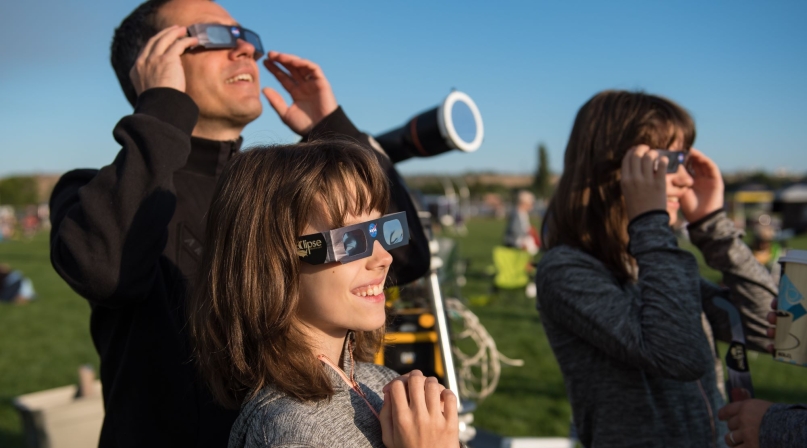Crowd management, emergency drills top county eclipse prep checklists

Key Takeaways
Over the course of four minutes on April 8, while Cuyahoga County, Ohio is bathed in mid-day darkness, monitors in the county’s Emergency Management Agency will be shining brightly.
A total solar eclipse has been on the calendar for decades, and counties in its path have been planning for years. Everyone knows where it will pass and how long it will be dark, but they have no idea how people will behave.
Will drivers get disoriented? Will crowds get out of hand? Will legions of social media users overload cellular service while streaming identical videos of the sun? How will cloud cover change things?
“We’re expecting traffic issues, momentary disruptions in communications and anything related to crowds,” said Mark Christie, the agency’s director. “Our role at the county is to be a repository of all the information, all those relationships that need to there so that if there were to be an issue during the event, we have already informed all the right people and already have the expectations set, already have the communications established.”
Counties are preparing by coordinating emergency services with viewing events, mostly organized by third parties, and planning traffic management. And, to keep people from staring directly into the sun.
This eclipse comes nearly seven years after another crossed the United States in August 2017, spanning from Oregon to South Carolina. Most of the course of that eclipse passed through rural areas, while April’s eclipse will pass through heavily populated parts of Texas, Arkansas, Indiana, Ohio and Western New York. An estimated 70% of the U.S. population lives within a day’s drive of the eclipse’s path.
“We’ve used tools to project some visitor estimates, but at the end of the day they’re just estimates,” Christie said.
And eclipse veterans say it’s worth the trip. For roughly four minutes, the moon will totally cover the sun and give a fragmented culture a unifying natural event to share. Outside of the 115-mile wide path of totality, Americans will see a partial solar eclipse, where the moon partially blocks the sun.
In 2017, NASA identified Hopkinsville, Ky., in Christian County, as the point of greatest eclipse, where the effects would be seen the longest.
“Standing in that shadow, feeling it get a little cooler out, you could start to hear the animals and the birds start chirping,” Brooke Jung, Hopkinsville-Christian County executive director of Tourism, told Nashville’s News Channel 5 in 2017. “Everything got serene. It was just such a magical time.”
Moon boons and traffic busts
Eclipse tourism was a big business in 2017.
A study by Southeast Missouri State University found that Cape Girardeau County, Mo. found that the eclipse had a modest positive benefit on expenditures in the county, with an estimated $280,000-$406,000 spent locally. Jung said Hopkinsville, Ky. drew roughly 100,000 visitors, who added $30 million to the local economy. Nebraska saw the eclipse curve diagonally across the state, generating $127 million in lodging and travel expenditures, with over 708,000 people, nearly 90% from out of state, traveling to the Cornhusker State for the event, making it the single greatest tourism event in state history.
With those visitors comes traffic.
Christie said that when Cuyahoga County spoke to counterparts in the path of the 2017 eclipse, Nashville-Davidson County, Tenn.’s warning was stark.
“They likened it to any large special event like a football game, where there’s the inclination for everyone to want to leave at the same time,” he said. “They had lots of congestion and that’s a concern for us, even though we’re a developed urban county that has a lot of people move in and out of our downtown on a daily basis.”
The challenge here is that large sporting events happen in a single place, surrounded by trained traffic control systems, whereas an eclipse lets people pick their spots. Christie hopes most visitors will opt for the unobstructed view along the shore of Lake Erie.
A South Carolina State University study found traffic volume increased 13% in the two hours after the eclipse through the 11 states along the path of totality. The study recommended restricting oversized trucks close to an eclipse and suspension of construction work. Nebraska, Kansas and Missouri saw reduced traffic the day of the eclipse, which researchers attributed to authorities’ advice to reduce errands around the eclipse.
The eclipse’s afternoon trip coincides with the end of the school day, so in the interest of taking thousands of school buses off the roads, many districts have canceled classes. Erie County, N.Y. Executive Mark Poloncarz is encouraging businesses to close if possible, to further reduce traffic.
“We are treating this in Erie County as if it’s a major snowstorm…and we’re just announcing that we’re closed, our offices are closed,” he said during a February press conference.
Hays County, Texas, south of Travis County’s high-tech haven of Austin, will adapt to visits from its neighbors while hoping they buck their stereotype a little. Mike Jones, Hays County’s director of Emergency Service, will be able to coordinate road closures through the navigation app Waze, which will help direct visitors who are not familiar with the county’s main viewing locations.
On the other hand, Jones is wary of his own county’s infrastructure shortcomings.
“We only have four charging stations in town, so I hope we don’t have too many visitors driving Teslas,” he said.
Hays County will also deploy its portable cellular tower to buttress its emergency communications capacity.
Hays County departments not involved in emergency services will be closed for the day. Meanwhile, Travis County and nearby Bell County preemptively declared states of emergency.
Private property owners in the unincorporated areas of Travis County will be required to notify the county if they plan to host a gathering with more than 50 people to watch the eclipse to allow first responders to plan ahead.
“We’re viewing it as a chance to ‘over plan’ for this and hope that it ends up as an opportunity to practice our organization and hopefully experience the eclipse with everyone else.” Christie said.
Lost in the traffic and public safety planning, counties have an opening to address a public health challenge — preserving residents’ eyesight.
Optometrists warn against looking directly at an eclipse without specialized eye protection at any time except for the period of totality — when the moon completely obscures the sun.
That exception only applies to the path of totality, the 115-mile wide path along which the moon will pass.
Chataqua County, N.Y. is distributing free eclipse glasses, and even more than county planners had anticipated.
“Somewhere along the line, someone got confused about how many glasses we wanted versus how much we had budgeted, and we wound up with a lot of glasses,” said County Executive PJ Wendel.
How many glasses arrived?
“About 300,000 pairs,” Wendel said.
Related News

Congress introduces Second Chance Act reauthorization
On April 16, the Second Chance Reauthorization Act of 2024 (H.R. 8028) was introduced in the U.S. House of Representatives with robust bipartisan support. NACo supports this legislation, which would reauthorize funding for Second Chance Act (P.L. 110-199) programs for five years.

HRSA offers funds to aid care transitions for justice-involved individuals
On April 10, the U.S. Department of Health and Human Services’ Health Resources and Services Administration (HRSA) announced the availability of $51 million in funding opportunities open to HRSA-funded health centers. HRSA-funded health centers, which serve over 30 million patients, play a crucial role in county healthcare systems emphasizing equity and accessibility in healthcare. This new initiative focuses on supporting individuals leaving incarceration by providing health services during the critical 90 days before release, assisting justice-impacted individuals with their return to the community by expanding access to primary healthcare—including mental health and substance use disorder treatment.

DHS announces $1.8 billion in preparedness grants to advance county security and resilience
On April 16, the U.S. Department of Homeland Security (DHS) unveiled more than $1.8 billion in funding for eight preparedness grant programs in Fiscal Year (FY) 2024. These grants play a crucial role in helping county governments bolster their readiness and response capabilities against terrorism and disasters.
County News
Solar eclipse to draw millions to mostly rural counties

